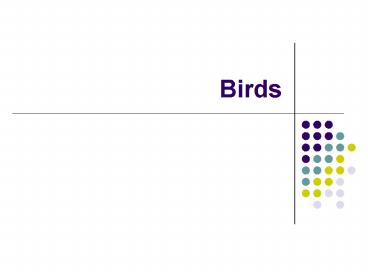Birds - PowerPoint PPT Presentation
1 / 21
Title:
Birds
Description:
Like reptiles, birds have clawed toes and protein scales on their feet. Fertilization is internal and shelled amniotic eggs are produced. Some birds are flightless, ... – PowerPoint PPT presentation
Number of Views:224
Avg rating:3.0/5.0
Title: Birds
1
Birds
2
What is a bird?
- Birds inhabit a variety of environments around
the world, including Antarctica, deserts, and
tropical rain forests. - Biologists sometimes refer to birds as feathered
dinosaurs. - Fossil evidence seems to indicate that birds have
evolved from small, two-legged dinosaurs called
theropods.
3
(No Transcript)
4
- Like reptiles, birds have clawed toes and protein
scales on their feet. - Fertilization is internal and shelled amniotic
eggs are produced. - Some birds are flightless, all birds have
feathers and wings.
5
Feathers
- A feather is a lightweight, modified protein
scale that provides insulation and enables
flight. - Preening running its bill through the feathers
to keep them in good condition for flight. It
also rubs oil from a gland near the tail into the
feathers. - Feathers are also good insulators because they
reduce heat loss. They also help in waterproofing
the bird.
6
Feathers continued
- Molting shedding of old feathers and the growth
of new feathers. - Usually in late summer
- Dont lose all their feathers at one time and are
able to fly while molting. - Wing and tail feathers are usually lost in pairs
so the bird can maintain a balance.
7
Wings
- Powerful flight muscles are attached to a large
breastbone called the sternum and to the to the
upper bone of each wing. - It supports enormous thrust and power produced by
the muscles as they move to generate the lift
needed for flight.
8
Energy
- Flight requires high levels of energy.
- A birds four chambered, rapidly beating heart
moves oxygenated blood quickly throughout the
body. This circulation supplies cells with the
oxygen needed to produce energy. - Respiratory system supplies oxygenated air to the
lungs when it inhales as well as when it exhales.
9
Breathing Cycles
- 1. Inhalation oxygenated air passes through
the trachea and into the lungs where gas exchange
occurs. Most air passes directly into the
posterior air sacs but some goes directly to the
lungs. - 2. Exhalation deoxygenated air is removed from
the lungs, oxygenated air returns to the lungs
from the posterior air sacs. - 3. The next inhalation, deoxygenated air in the
lungs passes into the anterior air sacs. - 4. Finally, at the next exhalation, air passes
from the anterior air sacs out of the trachea.
10
(No Transcript)
11
Endotherms
- Birds are able to maintain the high energy levels
needed for flight because they are endotherms. - Endotherm is an animal that maintains a nearly
constant body temperature that is not dependent
on the environment. - Feathers help with insulation. When in high
temperatures, birds flatten their feathers and
hold their wings away from their body. They also
pant to increase respiratory heat loss. - Allows bird to live in all environments.
- Endotherms must eat large amounts of foodto
sustain high energy levels.
12
Reproduction
- Bird have internal fertilization and lay amniotic
eggs usually inside a nest. - Eggs are encased in a hard shell, unlike the
leathery shell of reptiles. - Birds do not leave the eggs.
- Incubate or sit on their eggs to keep them warm.
Also, turn eggs to help them develop properly. - Some species the male and female sit on nest in
others only one does.
13
Hollow Bones
Wings
Beak
Air Sacs
Legs
Digestion
14
- Wings Birds have a variety of wing shapes and
sizes. Some birds have longer, narrower wings
adapted for soaring on updrafts, whereas others
have shorter, broader wings adapted for quick,
shirt flights among the forest trees. - Hollow Bones The hollow bones of birds are
strengthened by bony crosspieces. The sternum is
the large breastbone to which powerful flight
muscles are attached. - Beaks Birds have beaks, sometimes called bills,
covered by a protein called keratin, but they do
NOT have teeth.
15
- Legs The legs of birds are made up of mostly
skin, bone, and tendons. The feet are adapted to
swimming, perching, walking, or catching prey. - Digestion The digestive system of a bird is
adapted for dealing with large quantities of food
that must be eaten to maintain the level of
energy necessary for flight. Because birds have
no teeth, many swallow small stones that help to
grind up food in the gizzard. - Air Sacs About 75 of the air inhaled by a bird
passes directly into the air sacs rather than
into the lungs.
16
Diversity of Birds
- Depends on the environment in which they live and
the food they eat. - Ptarmigans feathered legs and feet that serve
as snowshoes in the winter, making it easier for
the birds to walk in the snow.
17
- Penguins are flightless birds with wings and
feet modified for swimming and a body surrounded
with a think layer of insulating fat.
18
- Large eyes, an acute sense of hearing and sharp
claws make owls well-adapted, nocturnal predators
able to swoop with absolute precision onto their
prey.
19
Shape of Beaks
- Hummingbirds have long beaks that are used to
obtain nectar from flowers. - Hawks have curved beaks that are adapted for
tearing apart their prey. - Pelicans have huge bills with pouches that they
use as nets for capturing fish. - A cardinals stout beaks are for cracking seeds.
20
Cardinal
Hawk
Hummingbird
Pelican
21
Origins of Birds
- Scientists hypothesize that todays birds are
derived from an evolutionary line of dinosaurs
that did not become extinct. The earliest known
bird in the fossil record is Archaeopteryx.































